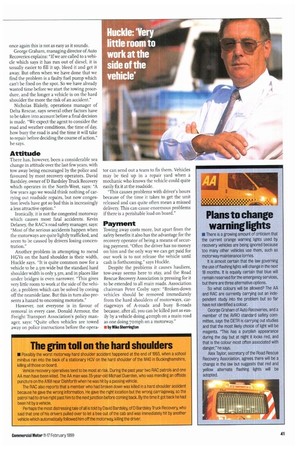HAR
Page 42

Page 43

If you've noticed an error in this article please click here to report it so we can fix it.
•
The safest way to deal with a broken-down vehicle on the hard shoulder is to tow it away—but it is not as easy as that when the vehicles are HGVs.
IV1ost of us have seen the advertisement for Nissan cars where a little girl points to the hard shoulder and says: "Daddy, why do we never go in that lane?" However, a lot of people do have to go on to the hard shoulder, and it is an extremely dangerous place, so much so that one vehicle recovery firm has issued notices to casualties warning them that they are standing on the most dangerous place on earth.
Official figures from the Department of the Environment, Transport and the Regions confirm these dangers. In 1997, the last year for which statistics are available, there were nine hard shoulder deaths, making up 6% of all motorway fatal accidents. This begs the question whether it is safer to remove a vehicle from the hard shoulder or to try and carry out repairs on the spot. Increasingly, vehicle recovery operators are opting to remove vehicles, but for HGVs this is not as easy as it sounds.
The problem is that large commercial vehicles cannot just be towed away—it is necessary to drop a prop or a half shaft or risk causing thousands of pounds worth of damage to the gear box.
John Huckle, managing director of Buckdale Recovery, a former president of the Association of Vehicle Recovery Operators, says: "This takes about 30 minutes if the bolts are good. However, quite often we have to cut the bolts off so the operation can take an r hour or more."
Huclde, along with other recovery operators, tends to adopt the attitude that his firm will do whatever is quickest, but once again this is not as easy as it sounds.
George Graham, managing director of Auto Recoveries explains: "If we are called to a vehicle which says it has run out of diesel, it is usually easier to fill it up, bleed it and get it away. But often when we have done that we find the problem is a faulty fuel pump which can't be fixed on the spot. So we have already wasted time before we start the towing procedure, and the longer a vehicle is on the hard shoulder the more the risk of an accident."
Nicholas Blakely, operations manager of Delta Rescue, says several other factors have to be taken into account before a final decision is made. "We expect the agent to consider the road and weather conditions, the time of day, how busy the road is and the time it will take to repair before deciding the course of action," he says.
Attitude
There has, however, been a considerable sea change in attitude over the last few years, with tow away being encouraged by the police and favoured by most recovery operators. David Bardsley, owner of D Bardsley Truck Recovery which operates in the North-West, says: "A few years ago we would think nothing of carrying out roadside repairs, but now congestion levels have got so bad this is increasingly a less attractive option."
Ironically, it is not the congested motorway which causes most fatal accidents. Kevin Delaney, the RAC's road safety manager, says: "Most of the serious accidents happen when the motorways are quite lightly trafficked, and seem to be caused by drivers losing concentration," Another problem in attempting to mend HGVs on the hard shoulder is their width, Huckle says. "It is quite common now for a vehicle to be 2.5m wide but the standard hard shoulder width is only 3.3m, and in places like under bridges is even narrower. "This gives very little room to work at the side of the vehicle, a problem which can be solved by coning off the nearside lane. But this in turn also presents a hazard to oncoming motorists."
However, not everyone is in favour of removal in every case. Donald Armour, the Freight Transport Association's policy manager, says: "Quite often vehicles are towed away on police instructions before the opera tor can send out a team to fix them. Vehicles may be tied up in a repair yard when a mechanic who knows the vehicle could quite easily fix it at the roadside.
"This causes problems with driver's hours because of the time it takes to get the unit released and can quite often mean a missed delivery. This can cause enormous problems if there is a perishable load on board."
Payment
Towing away costs more, but apart from the safety benefits it also has the advantage for the recovery operator of being a means of securing payment. "Often the driver has no money on him and the only way we can get paid for our work is to not release the vehicle until cash is forthcoming," says Huckle.
Despite the problems it causes hauliers, tow-away seems here to stay, and the Road Rescue Recovery Association is pressing for it to be extended to all main roads. Association chairman Peter Cosby says: "Broken-down vehicles should be removed immediately from the hard shoulders of motorways, carriageways of A-roads and busy B-roads because, after all, you can be killed just as easily by a vehicle doing 4 omph on a main road as one doing 70mph on a motorway."
• by Mike Sherrington




































































































